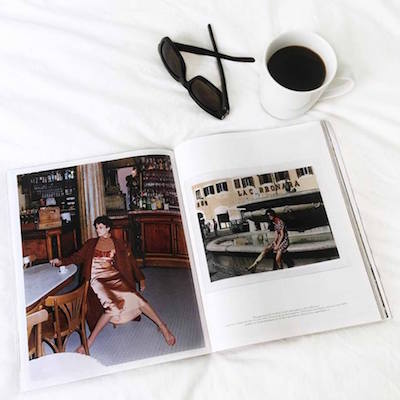 Image courtesy of Net-A-Porter's Porter magazine
Image courtesy of Net-A-Porter's Porter magazine
NEW YORK – Since the launch of Ipsos’ Affluent Survey in 1977 the way media is consumed has drastically changed, going from analog to digital, but the wealthiest individuals' behavior and sentiment has stayed relatively unchanged.
On Sept. 28 Ipsos presented the findings of its fall 2016 Affluent Survey, the 40th anniversary of its affluence-focused research. During the presentation, which gave an overview of Ipsos’ history, strategy and tools, the firm’s chief insights officer explained how wealth demographics and sentiment in the United States has evolved since the late ‘70s.
“The study, of course, has evolved over time with technology. It was in 1994 when we replaced our question about car phones with a question about cell phones – about a third of the population had cell phones at that time,” said Steve Kraus, chief insights officer at Ipsos. “In 1996, we started to ask about the Internet. In 2009, we had a real expansion of the survey content, including really beefing up our psychographics section.
“That’s also when we stared out Ipsos Affluent Barometer, because again, the study used to be fielded once a year, released once a year,” he said. “After 2008, we realized we had to have a much more timely way of taking the pulse of the affluent market.
“In 2010, we actually delayed going into field by a week or two because we knew Steve Jobs was going to introduce some amazing new 'doohickey,' and nobody really knew what it would be called – it was called the iPad, and it was a kind of ‘tablet,’ so we waited to make sure the terminology was accurate in our survey.”
#TBT
Mr. Kraus opened his presentation by explaining that the findings from the 1977 edition of the Affluent Survey have been “lost to the sands of time,” so for the purposes of his talk he would concentrate on the next available year: 1978.
In 1978, to be considered for Ipsos' report, a consumer needed to be in the $40,000 or more household income bracket. Those who fell into this income demographic made up the top 4 percent of the U.S. population, or approximately 5.4 million households.
Back then Ipsos, as it does today, concentrated on media consumption as the basis of its research. In 1978, media was siloed, with few options, and was consumed by nearly the entire population, albeit at different degrees.
For example, Ipsos considered 44 print publications for the 1978 survey. Thirty of those titles are still in print as of fall 2016, truly a nod to the strength and resilience of the medium, despite drastic changes to media since then.
In the 40 years since Ipsos’ first survey, democratization of luxury has escalated, tastes have changed and technologies have flourished. But, behavior and consumption is relatively the same.
Mr. Kraus referred to domestic air travel for vacation to illustrate this point. In 1978, 67 percent of affluent consumers flew domestically with an average of 3.3 trips.
By fall 2016, 64 percent of consumers in the $100,000 HHI bracket flew domestically for vacation, and 74 percent of the $250,000+ HHI demographic did the same. The average number of trips has barely changed.
 Photo courtesy of JetSmarter
Business travel, in comparison, has changed due to advances in technology such as livestream and video conference services. Business professionals in 1978 traveled domestically by plane an average 9.3 times per year. Today, that number has dropped to 5.1 for affluents and 6.5 for ultra-affluents.
Even the destinations have remained unchanged with Florida, California and New York remaining as the top three domestic locations visited for both leisure and business among affluents.
In regard to the fall 2016 Affluent Survey, Mr. Kraus shared that affluents’ brand taste is much more mainstream than would be expected. Brands such as Nike, Target, Ford, Amazon and Marriott are preferred, more so than labels and groups typically associated with affluence and luxury.
Consumers’ media consumption is what has evolved the most since the late ‘70s. In 1978, the only options for media was newspapers, magazines, television and radio.
Photo courtesy of JetSmarter
Business travel, in comparison, has changed due to advances in technology such as livestream and video conference services. Business professionals in 1978 traveled domestically by plane an average 9.3 times per year. Today, that number has dropped to 5.1 for affluents and 6.5 for ultra-affluents.
Even the destinations have remained unchanged with Florida, California and New York remaining as the top three domestic locations visited for both leisure and business among affluents.
In regard to the fall 2016 Affluent Survey, Mr. Kraus shared that affluents’ brand taste is much more mainstream than would be expected. Brands such as Nike, Target, Ford, Amazon and Marriott are preferred, more so than labels and groups typically associated with affluence and luxury.
Consumers’ media consumption is what has evolved the most since the late ‘70s. In 1978, the only options for media was newspapers, magazines, television and radio.
 Image courtesy of Ralph Lauren
Today, media options are immense, with an average 19 percent audience extension beyond the media's core platform seen for the 292 brands measured. Even between spring to fall 2016, this is a 3 percentage point increase.
Fifty-four percent of media brands have seen an increase in audiences, with a growth in digital at 77 percent. Web site audiences have also increased by 64 percent.
Evolving from analog to digital and mobile technology, the media advertising “sweet spot” is a mix of throwback platforms and modern channels. Web sites and social media, television, magazines and newspapers deliver broad reach with consumer interest in seeing the ads.
Interest is rising for ads seen in social, mobile and ambient contexts such as taxi and subway placement.
Affluent survivor: Print
With many more options for media today than in 1978, affluent consumers still consistently read magazines. According to Ipsos’ survey, 84 percent read a median of six magazine titles.
Of these titles, 82 percent reach publications in print, and only 37 percent read digital versions online. As a consumer segment, ultra-affluents read 17 percent more issues than total affluents.
In the time period considered for the fall 2016 Affluent Survey, 46 percent of the surveyed publications saw an audience increase.
The mainstream publications record a more varied, broad audience demographic, but niche titles that appeal to readers’ passion points have readerships with a much higher household income. Although this audience is more concentrated, the spending power is more than what is seen by mainstream titles.
Image courtesy of Ralph Lauren
Today, media options are immense, with an average 19 percent audience extension beyond the media's core platform seen for the 292 brands measured. Even between spring to fall 2016, this is a 3 percentage point increase.
Fifty-four percent of media brands have seen an increase in audiences, with a growth in digital at 77 percent. Web site audiences have also increased by 64 percent.
Evolving from analog to digital and mobile technology, the media advertising “sweet spot” is a mix of throwback platforms and modern channels. Web sites and social media, television, magazines and newspapers deliver broad reach with consumer interest in seeing the ads.
Interest is rising for ads seen in social, mobile and ambient contexts such as taxi and subway placement.
Affluent survivor: Print
With many more options for media today than in 1978, affluent consumers still consistently read magazines. According to Ipsos’ survey, 84 percent read a median of six magazine titles.
Of these titles, 82 percent reach publications in print, and only 37 percent read digital versions online. As a consumer segment, ultra-affluents read 17 percent more issues than total affluents.
In the time period considered for the fall 2016 Affluent Survey, 46 percent of the surveyed publications saw an audience increase.
The mainstream publications record a more varied, broad audience demographic, but niche titles that appeal to readers’ passion points have readerships with a much higher household income. Although this audience is more concentrated, the spending power is more than what is seen by mainstream titles.
 Image courtesy of Net-A-Porter's Porter magazine
For example, brands such as Trump International Hotel & Tower and Hermès were among the luxury advertisers spotted in an issue of Opera News earlier this year.
Opera News, the only national publication in the U.S. to cover opera globally, boasts an affluent and influential readership of more than 301,000 individuals. By tapping into a passion point, Opera News’ content and advertising blend appeals to the publication’s audience on an intimate and personal level that may not be achieved by a general lifestyle title.
According to the 2015 Ipsos Affluent Survey, Opera News reaches affluent consumers through a primary passion point.
Ipsos found that Opera News readers rank number 1 in spending across categories such as average household expenditures, high-end apparel and accessories and experiential luxuries such as tickets to cultural events and fine dining and wine. Likewise, Opera News’ audience also puts emphasis on luxury when traveling, with most preferring to fly first class and staying in five-star hotels, boutique properties or rental villas (see story).
“If you look at those publications with an average issue audience (AIA) of less than 2 million, they are 8 percent higher in income, 17 percent higher in spending,” Mr. Kraus said.
“As you move even further into the niche publications, the passion pubs,” he said. “You get passionate, enthusiastic people who are not only higher income, but higher in spending, and not just in endemic categories, but non-endemic categories as well, and that’s a good story to share.”
Image courtesy of Net-A-Porter's Porter magazine
For example, brands such as Trump International Hotel & Tower and Hermès were among the luxury advertisers spotted in an issue of Opera News earlier this year.
Opera News, the only national publication in the U.S. to cover opera globally, boasts an affluent and influential readership of more than 301,000 individuals. By tapping into a passion point, Opera News’ content and advertising blend appeals to the publication’s audience on an intimate and personal level that may not be achieved by a general lifestyle title.
According to the 2015 Ipsos Affluent Survey, Opera News reaches affluent consumers through a primary passion point.
Ipsos found that Opera News readers rank number 1 in spending across categories such as average household expenditures, high-end apparel and accessories and experiential luxuries such as tickets to cultural events and fine dining and wine. Likewise, Opera News’ audience also puts emphasis on luxury when traveling, with most preferring to fly first class and staying in five-star hotels, boutique properties or rental villas (see story).
“If you look at those publications with an average issue audience (AIA) of less than 2 million, they are 8 percent higher in income, 17 percent higher in spending,” Mr. Kraus said.
“As you move even further into the niche publications, the passion pubs,” he said. “You get passionate, enthusiastic people who are not only higher income, but higher in spending, and not just in endemic categories, but non-endemic categories as well, and that’s a good story to share.”
